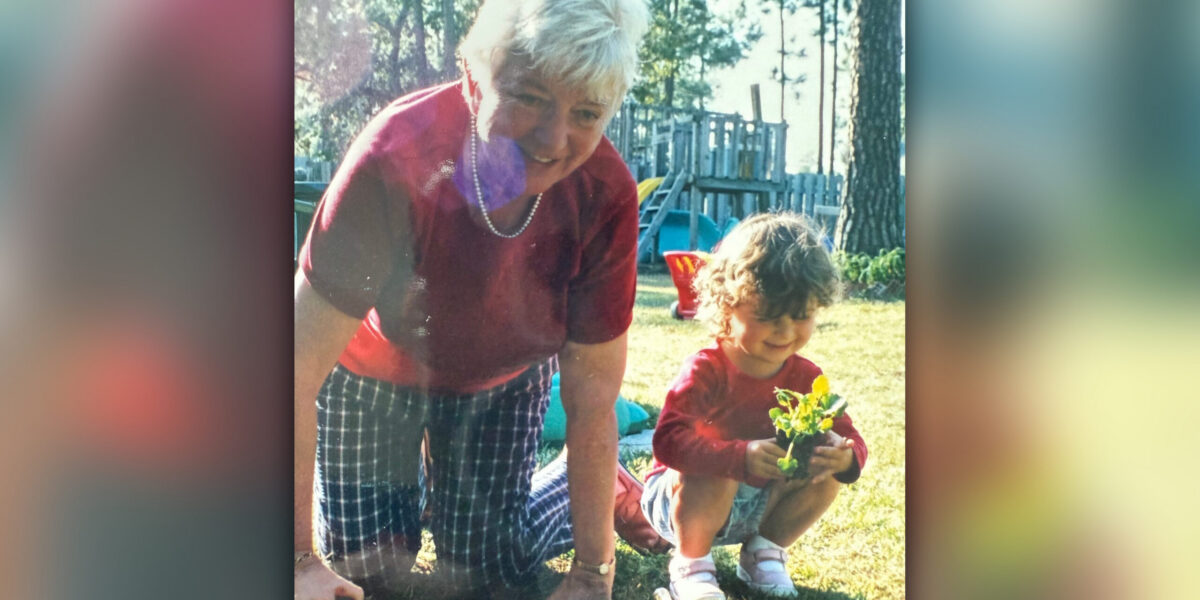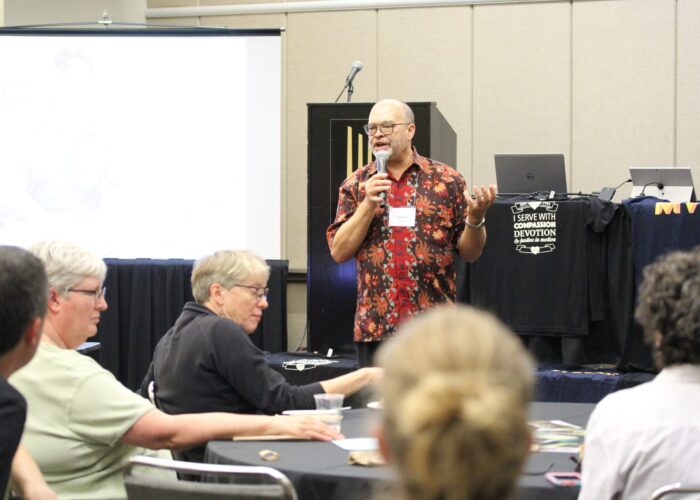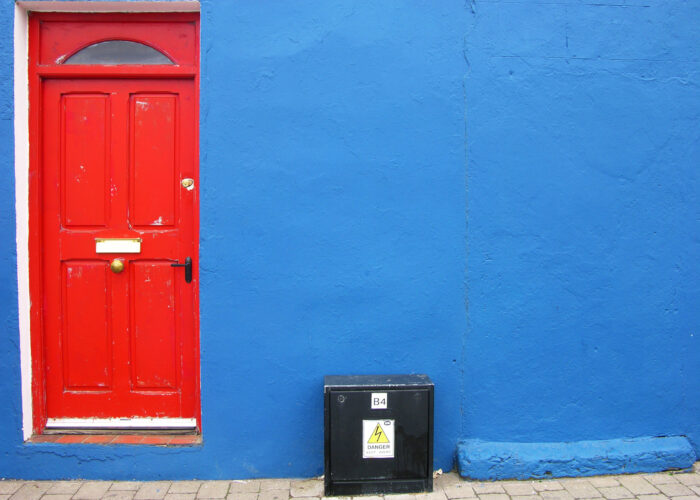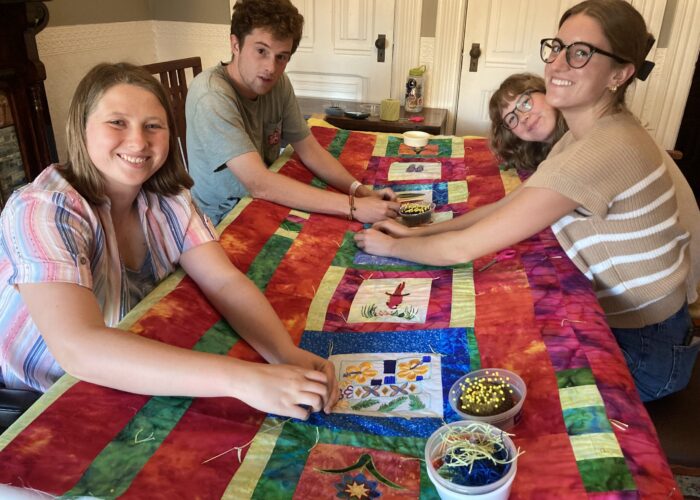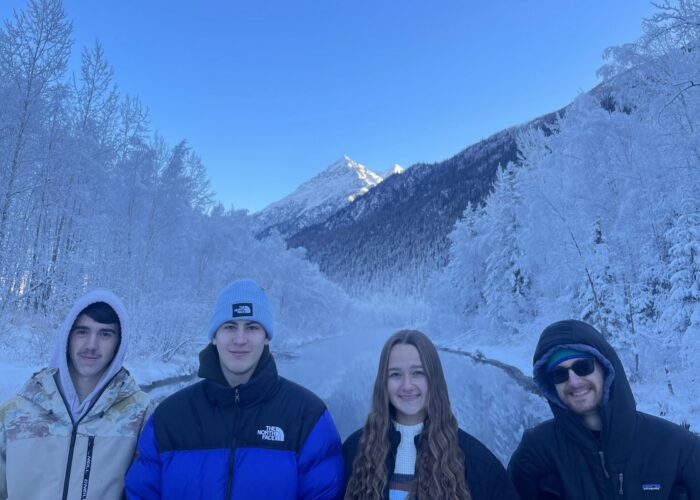Emily Keefer is a participant with the Alamosa, Colorado Mennonite Voluntary Service (MVS) unit. This post originally appeared on her blog, and has been edited here for length. Click here to read her blog in full. Mennonite Voluntary Service is a one-year service experience of Mennonite Mission Network for individuals age 20+, with the opportunity for a placement extension for an additional one to two years.
A few weeks ago, Mennonite Mission Network sent out an email asking if anyone wanted to write a piece combining their reflections of their MVS term with reflections on Holy Week or Easter. I let the email languish in my inbox. The only reflections I’d been having at the end of March and early April had been about death and dying as metaphors. Pondering the way that change and growth can feel like dying. The way that relationships and friendships die. The way that our political landscape feels colored each morning by the death of a program, or critical funding, or democratic norms. They weren’t particularly meaningful reflections, and I didn’t want to write about death for Easter, although it is certainly an integral part of Holy Week.
And then this morning I woke up to a phone call instead of an alarm. My breath caught slightly as I turned my phone over to see a call from my mother. I knew what it would be about before I answered the phone. My grandmother had passed away.
It is truly a strange feeling. That somehow, on another continent, a person who a few minutes ago was alive is now just… gone. That their existence slips away from us like a vapor. One moment there, the next, not. A hollow space, an indentation on a favorite sofa, an empty coat hanging on the wall.
I felt strangely prepared. The night before I had been watching a show telling the story of a woman with a terminal cancer diagnosis. The final episode centers on her time in hospice care, the hospice nurse walking her, her mom, and her best friend through the process of dying.
The nurse shares, “dying is a natural process. It’s like giving birth, or digesting food. Our bodies know how to do it. We know how it works, how it happens. It’s not a mystery.” She describes the stages of dehydration, increased sleep, a rally, and then eventually a breath out that isn’t followed by a breath in.
Once again, my reflections circle back to breath and I return to my newsletter from August. I wrote then, “The altitude here (7500ft above sea level) means that I often struggle for breath after climbing stairs or riding my bike. While challenging, I also think of it as a spiritual practice. Dan Snyder writes that “every out-breath rehearses the final breath of death and every in-breath remembers the first breath of life.”
I think about this in my yoga class. The final pose of each class is Savasana. The word literally means corpse pose. We lie quietly against our mats, eyes closed, sometimes draped in a blanket. We slow our breathing. In the Hindu practice it is a discipline that helps you rehearse for death. You release each breath slowly, and imagine the divine looking at you with love.
When I practice this position, I often get taken back to my Art History class at Wheaton with Dr. Milliner. At the beginning of every class he would clang a mallet against a singing bowl and we would take a moment to look at the icons in the corner of the classroom. I would look at Jesus and he would look back at me. I would practice being seen by the divine, receiving unconditional positive regard.
Now as I lie on my borrowed mat, I take a deep breath in, imagining God with me even before I was born. And then I release that breath, relaxing my body into the mat. God will be with me in death.
Perhaps the practice of rehearsing your own death strikes our modern ears as a morbid practice. But is that not what we do each Ash Wednesday? Remember you are dust, dirt, soil. We are mortal creatures, made of earth, and returning to the earth.
I think that the Hindu practice of Savasana also finds good company with the Christian tradition of Lent – time in the church calendar where we practice dying to oneself. And as Lent fades into Holy Week, I am reminded that Christianity is built on the subversive embrace of a cruciform life, of death as a way of life, death as a way through to eternal life. In fact, the rehearsal of death for me, whether through Savasana or a Lenten fast, is a part of what it means to practice the way of Christ.
Throughout Lent I have found myself singing “Seed Scattered and Sown,” a Lenten communion hymn. I love the imagery of Christ as a seed, broken, scattered, and buried in the earth. Christ follows the journey each human will walk, our bodies returning to the earth.
Holy week has been a window of time in which to process the loss of my granny. Holy Week itself is a week of grief. It’s a week that includes loss of power, loss of dignity, loss of friends, loss of our own dear bodies. It is the bitter parts of the human experience boiling together in one intense week.
Christians worship a God who physically died – who went through those known stages of dehydration, rally, and then an outbreath not followed by a breath in.
When each of us begin to tread these steps we are not alone, God has gone before us. There is nowhere we can go that God has not gone, that God will not go with us.
My granny died on her birthday, April 14th. In some ways this is a sad fact, as she was unable to receive the flowers and gifts sent to her by those who loved her. In other ways, it is a beautiful image of a life born into love, lived in love, and received in love. The God who was with her at her first intake of breath, surely held her as she took her last. We are as loved on our first day as on our last, an arc of love that leads us into the world beyond the veil.
Easter Sunday came this year as a whisper. A pale sunrise after a dark night. But if Christianity includes the spiritual practice of rehearsing death, of walking a cruciform path, we must also practice Resurrection. We rehearse this rebirth every Easter, but also every morning that we wake from sleep with a breath in.
Sometimes this takes a lot of imagination. When I look out my window, it may look as though the trees are all dead. But really the roots are just pushing deeper into the soil, into the earth, into the source.
We journeyed towards Easter beginning with Ash Wednesday and a reminder of our morality. Through Lent we practiced the cruciform way, letting habits and excess die in order to live as Christ. But this path ends with the Resurrection – the definitive act of the world. Life triumphing over death, love triumphing over evil, forgiveness over hate, nonviolence over violence. The oppressed gain a subversive victory over the oppressor. It ends with life bursting forth from the soil where the seed had been buried. Lent and Holy Week are sure to remind us of our mortality, which we remember with every out breath. And yet, we are loved dust. We will be resurrected earth. Perhaps one day we will all take a collective breath in, a sigh of relief, our eyes fluttering open as Jesus says each of our names and we will wake into a new world. I love the words of Arundhati Roy who writes, “Another world is not only possible, she is on her way. On a quiet day I can hear her breathing.”1
One of my favorite things I learned about my Granny I only learned after her passing. Esther was named after the season she was born in – Easter. I think it is so beautiful to be named after a day celebrating Christ’s resurrection and the defeat of death and brokenness. The light I see in the most pitch-black shape of the loneliest shadow is that my grandmother – named for resurrection, born and died on the same day was saturated in the love of God, that her life, in her story I can see the truth of the world – that the very last word is Love. And although I don’t know for sure, I suspect that the very first word of our new world will also be Love.
1 Arundhati Roy: “Another world is not only possible, she is on h…”

